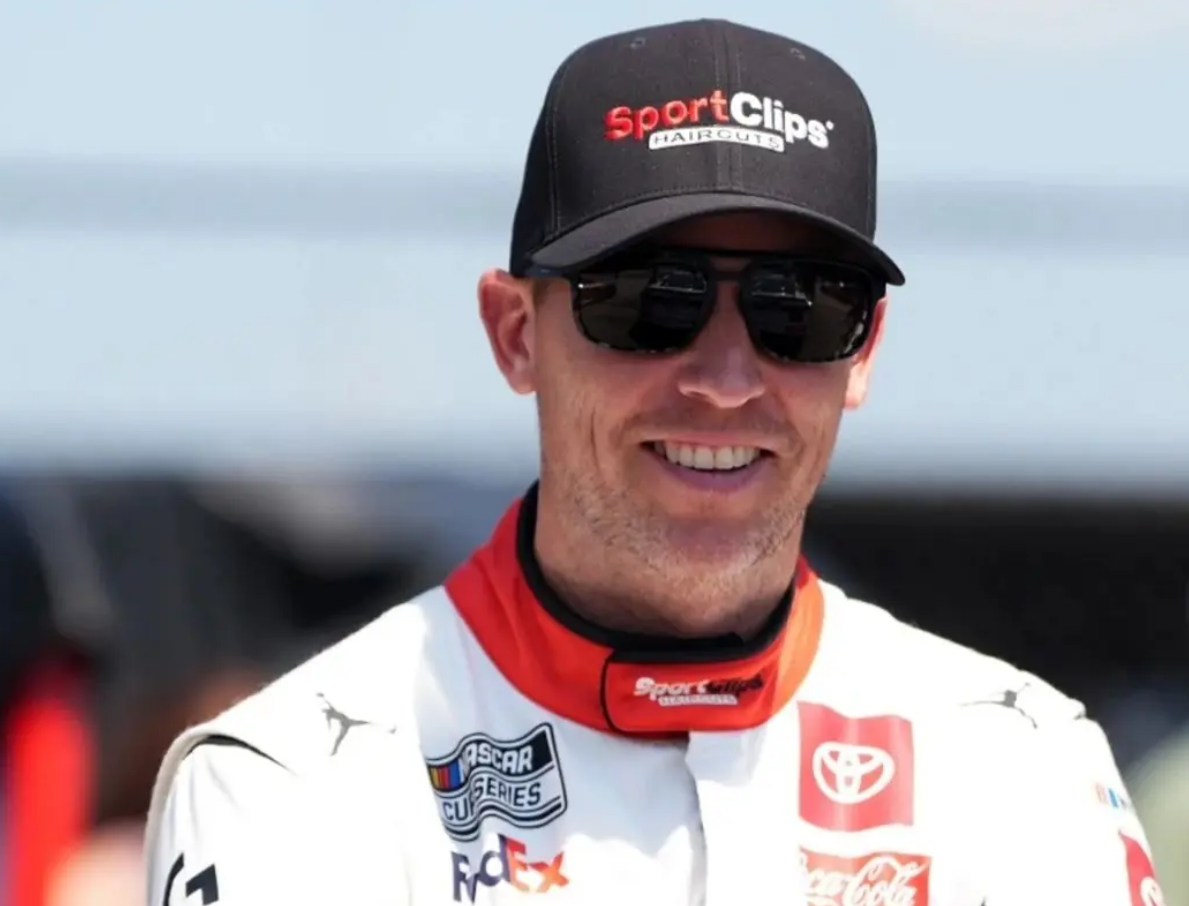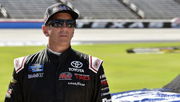

For years, Richmond Raceway felt a little too familiar, tight racing, sure, but not much excitement. Even Denny Hamlin, known for his short-track skills, had started to lose interest. But in 2025, Goodyear changed the game with a bold new tire setup. Suddenly, grip faded fast, strategy mattered more, and the racing came alive. The difference was immediate, and no one felt it more than Hamlin, who couldn’t hide how much fun he was having.
Watch What’s Trending Now!
That kind of transformation didn’t happen overnight. For nearly seven decades, Goodyear has been NASCAR’s sole tire supplier, handcrafting over 100,000 race tires each year at its Akron, Ohio, facility. From the six-ply tire in 1972 to radial designs in 1989 and multi-zone treads in 2013, Goodyear’s evolution led to today’s 18-inch Eagle tire used on NASCAR’s next-gen cars.
ADVERTISEMENT
Denny Hamlin is thankful for Goodyear’s smart plan
Throughout NASCAR’s history, tire dynamics have shaped the competition. The late 1980s tire war between Goodyear and Hoosier saw teams choose between softer, faster tires or more durable Goodyears, sparking dramatic on-track battles but also safety concerns and failures, ultimately reinforcing Goodyear’s dominance. These rivalries’ responses highlight how tire strategies can redefine both performance and the evolution of the sport.
And now in 2025, NASCAR’s tire rules at short tracks like Richmond have evolved to shake up strategy. Teams receive eight sets of tires plus one set carried over from qualifying, pushing drivers to balance grip and conservation. Richmond’s package included an open tire compound, softer, and faster but wear-prone tires, used on one side of the car to create strategic trade-offs in setup and race planning.
And according to Denny Hamlin, at Richmond, Goodyear’s gamble paid dividends. Speaking on his Actions Detrimental podcast, Hamlin applauded the tire makers for delivering serious performance variation. He said, “Thank you, Goodyear, for bringing a tire that had over 2 to 2 1/2 seconds of fall-off. Fantastic—83%, yes, that’s great. Deserving, very, very deserving in that, especially, you know—you know, Richmond. Richmond was kind of one of the very first short tracks that was getting the “oh man, this is kind of boring” type of feel, right? And, like, it’s good to see that. Like, OK, yeah, the tires do matter, right?”
ADVERTISEMENT
Even though Denny Hamlin wasn’t the winner at Richmond, his tire-centric performance stood out. Amid multiple incidents, including a 16-car pileup, Hamlin moved through the field and ended the race inside the top contenders, showing masterful tire management after the chaos began.
His ability to adapt to the tire fade curve while navigating traffic and restarting is an avid reminder of how much tire strategies are now involved with success at the track. According to Hamlin, getting the tire degradation right puts the focus back on driver skill, and that is exactly what the fans want to see. He also reflected on how the tire let drivers make moves that were nearly impossible last year with the hard compound setup.
ADVERTISEMENT
The Joe Gibbs Racing driver went on to add, “Everyone’s got a lot of grip because the tires got a lot of grip and then all of a sudden people start passing. It’s like that’s what we wanted to see. And so that puts it back into the driver’s hand. And hopefully this is something that and this will be our loud and tire as well. So something to look forward to there. It looks, it seems like they’re trying to make this our standard short track tire because I believe it is the same as Martinsville now Richmond, I’m sure there’s another in there, but. We’ve softened up the tires. It’s a really good thing.”
In the 2025 Cook Out 400 at Martinsville Speedway, Denny Hamlin dominated by winning the pole, leading the most laps, and taking the checkered flag, but much of the conversation centered on Goodyear’s tire setup. NASCAR and Goodyear opted for the same soft compound tire combination used in the 2024 fall playoffs, favoring consistency across short tracks rather than giving teams the choice between primary and options.
While some insiders argued with the return of the option to spice things up, the soft compound still provided early grip with enough falloff to reward tire management and create opportunities for passing. This approach was built on Martinsville’s recent evolution, where a softer left-side tire paired with an option-right side had been tested in 2024 to enhance short track racing dynamics.
ADVERTISEMENT
The result in 25 was a grippy yet degradable tire package that played directly into Hamlin’s hand, allowing him to maximize performance over long runs and secure a commanding victory.
But now, another problem looms, as Denny Hamlin agreed with Kyle Petty’s view on the Gen 7 car. Hamlin has also weighed in on what makes a difference in the winning stats.
Top Stories
Another Almost Fatal Disaster Surfaces From Statesville Airport Amidst Ongoing Greg Biffle’s Crash Investigation

NTSB Appeals for Greg Biffle’s Wife’s Alleged In-Flight Text Messages as Crash Investigation Heats Up

Horrific Aerial Footage of Greg Biffle’s Fatal Crash Emerges Leaving NASCAR Community in Tears

Donald Trump Issues Moving Message of Condolence for NASCAR’s Greg Biffle & Family During North Carolina Address

Footage Surfaces of Florida Police Arresting NASCAR Veteran Over Disturbing Public Misbehavior

ADVERTISEMENT
Denny Hamlin reflects on the race-winning formula
NASCAR’s next-gen cars continue to spark divided opinions regarding the performance. Many drivers, most notably Denny Hamlin, have voiced strong criticism of the new generation, repeatedly calling for regulatory changes. Despite the pushback, NASCAR has yet to implement any major adjustments to the format.
Recently, the Joe Gibbs Racing veteran revisited some of his earlier comments about the role of luck in winning races, a perspective originally applied to the old-gen cars, but which he believes doesn’t fully apply to today’s racing. Having competed in the cup series since 2005, Hamlin’s long experience across different eras of NASCAR gives weight to his critiques of the next-gen machines.
Back in 2012, the 44-year-old had broken down championship success at 20% luck, 40% driving skill, and 40% car and team performance. However, when reflecting on those remarks in the light of the current generation, Hamlin admitted that the balance has shifted.
ADVERTISEMENT
When asked last week about the subject, the driver of the No. 11 car said he still stood by the idea that 40% of winning came down to the driver’s ability. But compared to the past, he felt luck played a bigger role, 30%, with the remaining 30% depending on the team in the car. He said, “I still think it’s 40% Driver, but now I switch car and luck to 30% each.”
Not long after, though, Hamlin revised his stance once again. Upon further reflection, he argued that the true formula has shifted in favor of the Driver, placing more emphasis on skill than Fortune or machinery. In his view, winning today comes down to 65% Driver, 25% team and just 10% luck. He concluded by saying, “I lowered luck because it’s not a factor in winning as much as being good is. It is still a factor and some wins, but great drivers have more opportunities to win because of their skill level.”
ADVERTISEMENT
ADVERTISEMENT
ADVERTISEMENT

